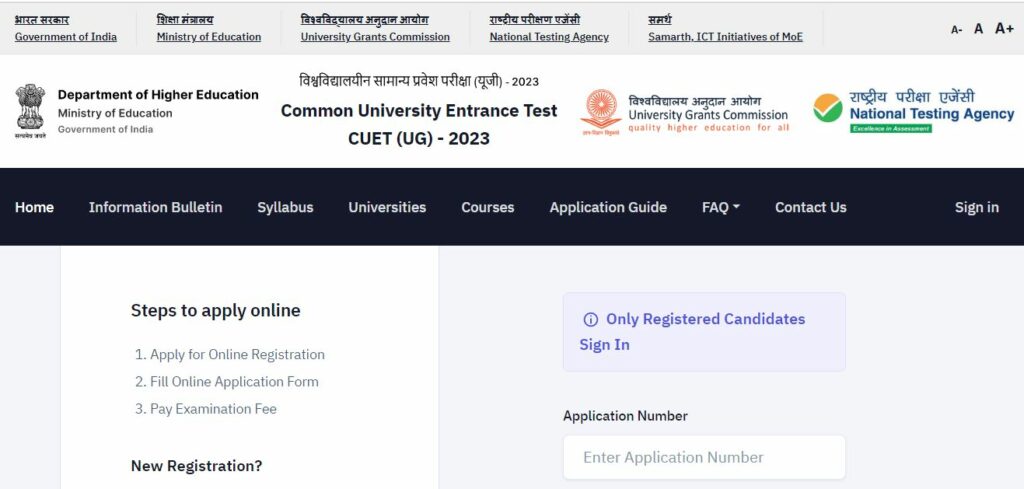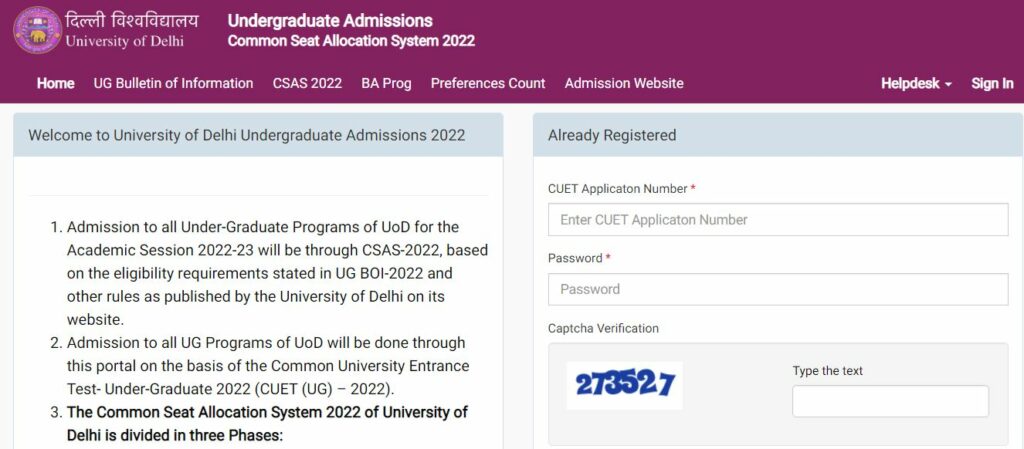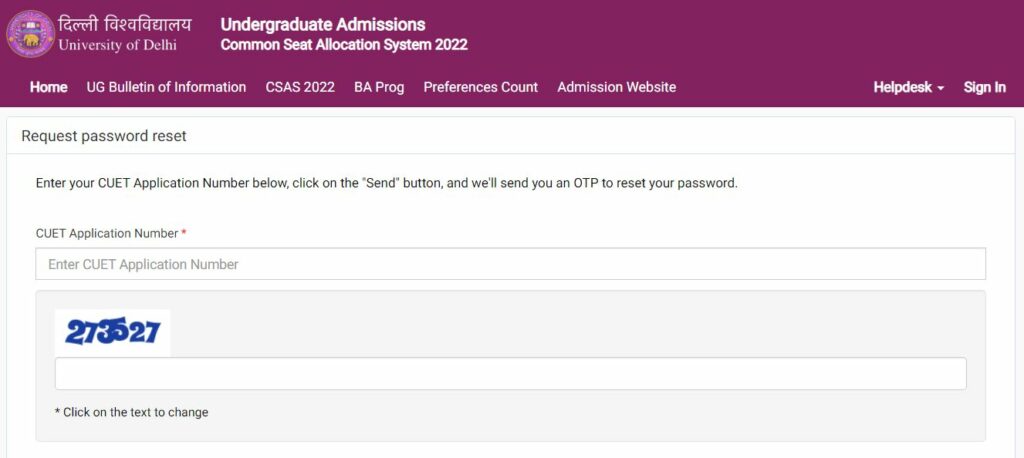Delhi University established the Common Seat Allocation System (CSAS) for undergraduate admissions for 2023-24. Interested students can register on the official website to apply online for DU CSAS Portal Registration Admission 2024 affiliated colleges of Delhi University.
Contents
- 1 DU CSAS Portal Registration 2024
- 1.0.1 Delhi University CSAS Portal Registration Eligibility Criteria
- 1.0.2 Documents required for DU admission
- 1.0.3 CSAS Portal Registration Admission 2024 Fee
- 1.0.4 CSAS Portal Registration 2024 Admission Process
- 1.0.5 How do you apply online for CSAS Portal Registration?
- 1.0.6 Steps to Login
- 1.0.7 How do we recover the password for the DU CSAS application form?
- 1.0.8 FAQs
DU CSAS Portal Registration 2024
DU CSAS Portal Registration 2024 is open for 21 days. Delhi University Admission Schedule 2024 will be declared now, and in this academic year, the CSAS portal will be an important part of admission in DU-affiliated colleges.
And the process of DU admission 2024 is in three stages. As the Common Seat Allocation System is enabled, students have to register through the DU CSAS application form available on the Common Portal and make a single-time (non-refundable) payment at this stage of application.
If the student is eligible for admission in the course of their choice, they can choose a combination of courses and colleges.
Delhi University advises students to opt for various courses and college combinations. Still, at this point, they should also be careful about their options; once they choose, they cannot change.
Through the CSAS DU 2024 admission process, in the third stage, seats are allotted, which is done in several rounds. After the release of the DU UG Admission Merit List 2024, students should check the allotted seats and colleges in CSAS.
Delhi University CSAS Portal Registration Eligibility Criteria
- BA. And for B. A (Hons in Foreign Language) courses, the eligibility criteria are completing a 10+2 level board examination with a minimum of 40% and aggregating 45% marks from a recognised board.
- For BA (H in Indian languages), the basic eligibility criteria are completion of a 10+2 level board examination with a minimum of 45% marks or 40% marks in aggregate and 50% marks in the relevant subject from a recognised board.
- For B.Voc and B.Com., the candidate must complete a 10+2 level board examination from a board with a minimum of 40% marks in aggregate.
- B.Com.(H), the candidate must have completed a 10+2 level board examination with a minimum of 45% marks. Candidate should also have cleared Mathematics or Business Mathematics in the qualifying examination.
- For a B.Sc.(H) in Statistics and Mathematics, the candidate should have completed the 10+2 level board examination with a minimum of 45% marks and 50% marks in Mathematics.
- For B.Sc.(H) in Botany, Microbiology, Zoology, Anthropology, or Biological Sciences, the candidate should have passed the 10+2 level board examination with a minimum of 55% marks and 50% marks in English.
- BMS For, the candidate must have completed the 10+2 level board examination with a minimum of 60% marks in aggregate in four subjects, including English, Mathematics and two other subjects.
Documents required for DU admission
- Class 12th mark sheet
- Class 10th mark sheet
- CUET scorecard, once available
- Migration/Transfer certificate
- Photographs
- Signature
- Application form printout
- Certificate for reservation
CSAS Portal Registration Admission 2024 Fee
After submitting their Delhi University CSAS Admission 2024 form, students cannot change personal details like Name, Photo, Caste and Signature. General category students pay a non-refundable application fee of Rs 250, and reserved category students as an application or admission form in DU—Rs 100.
CSAS Portal Registration 2024 Admission Process
Admission will be conducted in three stages through a common seat allotment process –Check the complete admission process for admission to UG courses at Delhi University through the Common Seat Allocation System (CSAS):
Step 1: CSAS 2024 Application Form:
- Aspirants must complete the CSAS 2024 application form by paying a one-time, non-refundable application fee at the centralised admission portal.
- ECA and Sports Quota candidates have to pay an additional fee.
2nd Step: Selection of courses and college preferences:
- The second phase will start after the declaration of CUET UG exam results.
- After the confirmation of the CUET UG 2024 result, eligible candidates must select courses and fill preference of desired colleges in the centralised CSAS portal.
Step 3: Seat Allotment and Final Admission:
- The merit list will be declared based on CUET UG scores.
- Several rounds of seat allotment conduct
- Candidates should check whether they have been allotted a seat on the CSAS dashboard. If allotted, candidates should accept their seats for the particular round on or before the given date.
- Allotment of seats was based on multiple factors like a combination of college and program selected position of the person in the merit list, category of candidate (SC/ST/OBC/EWS/UR) and availability of seats.
- After accepting the seat, the university will check the eligibility, verify the documents and confirm the admission after receiving the fee payment.
How do you apply online for CSAS Portal Registration?

- Browse the official website of Delhi University to get the latest updates on DU UG Admission.
- Then click on the UG admission link.
- And now, select CUET (UG) and click the Registration link.
- Fill out the DU UG Admission Application Form and upload the documents in the prescribed format.
- The University of Delhi UG Admission Pay the fee and click on submit.
- After submission of the Delhi University UG Application Form, the selection-filling process will open, and students can select the college of their choice for admission to the UG course.
Steps to Login

- Visit the authorised website of Delhi University.
- Enter the CUET Application Number, Password and Captcha and click “Login”.
- Read the instructions carefully and click “I have read the important information.
- Now, click on the “Submit” tab.
- Add the required personal details in the DU 2024 application form.
Fill the details
- Candidate Name
- Date of birth
- Email ID
- Aadhaar Card Number
- gender
- category
- Address (Correspondence and Permanent)
- Provide ward quota details.
- Family details
- Category/Quota Details like Children/Widows of Armed Forces Personnel, Prime Minister’s Special Scholarship Scheme for J & K Candidates, PWD, Kashmiri Migrants, Sikkimese Students nominated by Govt.
- Bank details for the refund
- Then click on Submit.
How do we recover the password for the DU CSAS application form?
Suppose any candidate needs to remember their DU. Application Password: Delhi University will provide an opportunity to retrieve the password using their registered email address.
Steps to Recover DU. Application Password

- Visit the official website.
- Go to the DU CSAS Portal Registration Admission homepage.
- ‘Forgot Password? Section under Application Login Space.
- Type your CUET registered email ID and press ‘Send OTP’
- You will receive an OTP to help you reset your password
- Type and create a new password
- Click on ‘Submit OTP’.
FAQs
Delhi University will release DU. Registration 2024 form on the Common Seat Allocation System (CSAS) portal by May 20.
The Common Seat Allocation System (CSAS) is an online admission system that Delhi University uses to allocate seats to candidates who qualify for their courses. The system utilises a centralised merit list based on the marks obtained in the final qualifying examination, followed by a detailed verification process.
“Candidates willing to be admitted to Delhi University should only apply through the CSAS-2024 application form. Application number of CUET (UG)-2024 is mandatory to apply for CSAS-2024.
CSAS Phase 1 involves the registration of counselling of candidates who have selected Delhi University for admission in their CUET 2024 application form. In the second stage, or ‘preference filling’, candidates can select their program and college combination preferences.